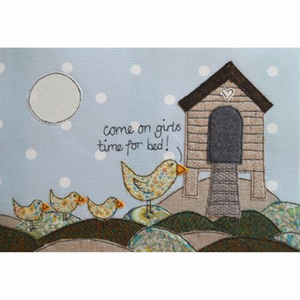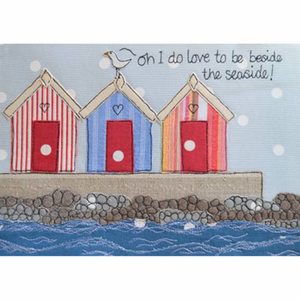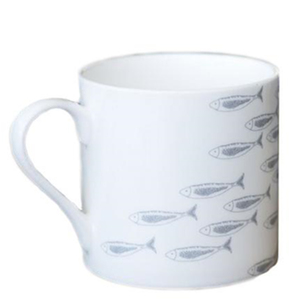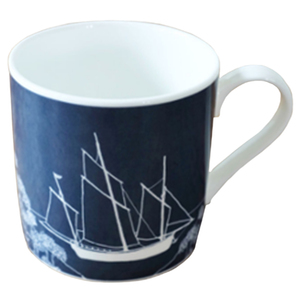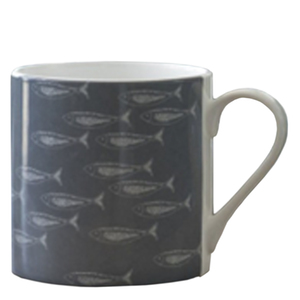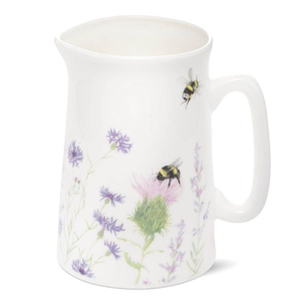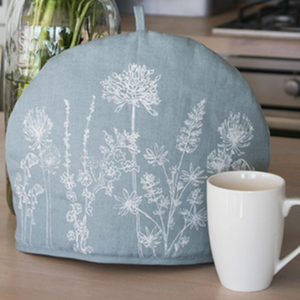
A little bit of History
An Englishman’s Home Is His Castle
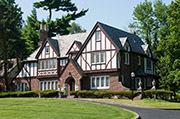 The Meaning of this ancient saying is that an Englishman’s home is his refuge.
The Meaning of this ancient saying is that an Englishman’s home is his refuge.Since at least the 17th century it has been a legal precept in England that an Englishman should be able to control what happens in their own home and that no one else should tell them what to do there and that no one may enter a home unless by invitation. This was established as common law by the lawyer and politician Sir Edward Coke (pronounced Cook), in The Institutes of the Laws of England, 1628:
"For a man's house is his castle, et domus sua cuique est tutissimum refugium [and each man's home is his safest refuge]."
What was meant by 'castle' was defined in 1763 by the British Prime Minister - William Pitt, the first Earl of Chatham, also known as Pitt the Elder:
"The poorest man may in his cottage bid defiance to all the forces of the crown. It may be frail - its roof may shake - the wind may blow through it - the storm may enter - the rain may enter - but the King of England cannot enter."
The law was originally established to give householders the right to prevent entry to their homes and that the government had no right to interfere in their private lives. However the 'Englishman's home is his castle' rule did not establish a man's right to take actions inside the home that would be illegal outside it.
The principle was exported to the United States where the 'Englishman' was removed from the phrase. In 1800, Joel Chandler Harris's biography of Henry W. Grady, the journalist and writer on the US Constitution, included the following:
"Exalt the citizen. As the State is the unit of government he is the unit of the State. Teach him that his home is his castle, and his sovereignty rests beneath his hat."
The English Castle
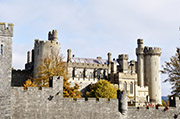 A castle can be defined as a large fortified building or set of buildings usually inhabited by nobility or feudal lord, providing the owner with a secure base from which to control his lands. Castles are seen as a symbol of wealth and power and their characteristics include thick walls, battlements, towers and a moat built to withstand an attack. There are over 1,500 castle sites in England. Many of these castles have vanished or left almost no trace. The present list includes more than 800 medieval castles of which there are visible remains, with over 300 having substantial surviving stone or brick remains.
A castle can be defined as a large fortified building or set of buildings usually inhabited by nobility or feudal lord, providing the owner with a secure base from which to control his lands. Castles are seen as a symbol of wealth and power and their characteristics include thick walls, battlements, towers and a moat built to withstand an attack. There are over 1,500 castle sites in England. Many of these castles have vanished or left almost no trace. The present list includes more than 800 medieval castles of which there are visible remains, with over 300 having substantial surviving stone or brick remains. Origins of an English Castle
Following the Norman Invasion of 1066 many castles were built across England. Castles continued to be built in England reaching a peak in 13th Century During the 14th Century heavily fortified castles gave way to more lightly fortified structures known as fortified manor houses. Surprisingly the last castle to be built in England; Castle Drogo, was built from 1911 and was finished in 1930. It was commissioned by Julius Drewe (businessman and founder of the Home and Colonial Stores) to designs by architect Edwin Lutyens, and is a Grade I listed building. Built of granite it is an imposing site rising above the Teign Valley and Dartmoor in Devon. Unfortunately Julius Drewe only got to spend one year there after it completion before his death. In 1974 Castle Drago was given to the National Trust where it has since been open to the public.
Prominent Castles in England
Windsor Castle
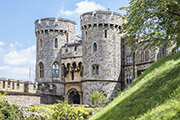 Windsor Castle is the oldest and largest inhabited castle in the world. It has been the family home of British kings and queens for almost 1,000 years. It is an official residence of Her Majesty The Queen, whose standard flies from the Round Tower when she is in residence.
Windsor Castle is the oldest and largest inhabited castle in the world. It has been the family home of British kings and queens for almost 1,000 years. It is an official residence of Her Majesty The Queen, whose standard flies from the Round Tower when she is in residence.
The Queen spends most of her private weekends at Windsor and takes up official residence for a month over Easter (March to April), known as Easter Court. The Queen is also at Windsor for one week each June, when she attends Royal Ascot and the service of the Order of the Garter. St George’s Chapel within the Castle Precincts is the spiritual home of the Order of the Garter With roots in the Middle Ages the order of the garter is the oldest order of chivalry in the world. Founded at Windsor by Edward III in 1348, the Garter knighthood consists of the monarch, the Prince of Wales (whose title automatically qualifies him as a Knight of the Garter), and 24 knights. Its Knights still attend a Service of Thanksgiving in the chapel of their patron, St George.
Over a million people visit the castle each year. Presidents Jimmy Carter, Ronald Reagan and Bill Clinton have all been guests of the queen at the palace.
The Tower of London
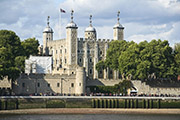 Officially titled Her Majesty’s Royal Palace And Fortress, The Tower of London; this historic castle is located on the north bank of the River Thames. At the heart of the Tower of London is the White Tower which gives the castle its name. It was built by William the Conqueror in 1078 following the Norman Conquest and at the time the tower would have visually dominated the surrounding area. It was built to strike fear and submission into the citizens of London.
Officially titled Her Majesty’s Royal Palace And Fortress, The Tower of London; this historic castle is located on the north bank of the River Thames. At the heart of the Tower of London is the White Tower which gives the castle its name. It was built by William the Conqueror in 1078 following the Norman Conquest and at the time the tower would have visually dominated the surrounding area. It was built to strike fear and submission into the citizens of London.
The castle was used as a prison from 1100 until 1952 and housed the notorious English gangsters the Kray twins who operated out of the East End of London during the 1950’s and 60’s. In its former years the Tower of London was a grand palace serving as a royal residence.
The Tower of London has played a prominent role in English history and controlling it has been important to controlling the country. The Tower has served as an armoury, a treasury, the home of the Royal Mint, a public records office, and the home of the Crown Jewels.
In the late 15th century the castle was the prison of the Princes in the Tower (Edward V of England and Richard of Shrewsbury, Duke of York.) who disappeared among accusations that they were murdered by Richard III who took Edward V’s throne to become King of England. Other royal prisoners included Anne Boleyn; second wife of Henry VIII before she was beheaded, and Elizabeth I their daughter before she became queen. Traitor's Gate, the entrance from the River Thames, is known for being the last stop for those on their way to their execution.
Guarding the Tower
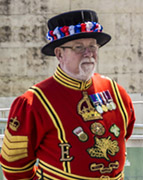 The Yeoman Warders known as ‘Beefeaters’ guard the Tower of London. They have long been symbols of London with their distinct uniforms. It is thought their nickname is derived from their position in the Royal Bodyguard, which permitted them to eat as much beef as they wanted from the king's table.
The Yeoman Warders known as ‘Beefeaters’ guard the Tower of London. They have long been symbols of London with their distinct uniforms. It is thought their nickname is derived from their position in the Royal Bodyguard, which permitted them to eat as much beef as they wanted from the king's table.
They are a detachment of the ‘Yeomen of the Guard’, and they’ve formed the Royal Bodyguard since at least 1509. Their origins stretch back as far as the reign of Edward IV (1461-83).
Legend of the ravens
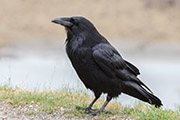 Ravens have always been kept at the Tower of London. When Charles II asked for the Ravens to be removed, he was advised that if the Ravens were removed, The Tower would crumble and a great harm would befall the nation. Ever since at least 6 ravens have been kept at the Tower.
Ravens have always been kept at the Tower of London. When Charles II asked for the Ravens to be removed, he was advised that if the Ravens were removed, The Tower would crumble and a great harm would befall the nation. Ever since at least 6 ravens have been kept at the Tower.
Despite their having one wing trimmed, some ravens do in fact go absent without leave and others have had to be sacked. Raven George was dismissed for eating television aerials, and Raven Grog was last seen outside an East End pub.
Today the Tower of London is an iconic symbol of London. It is one of the country's most popular tourist attractions with over 2 million visitors every year. Being such a prestigious and important castle it is protected as a World Heritage Site.
Highclere Castle
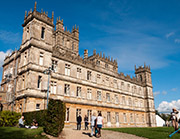 Home to the television series Downton Abbey, Highclere is one of England's most beautiful Victorian Castles. The Carnarvon family has lived at Highclere since 1679, and the castle was largely rebuilt for the third Earl following a design by Sir Charles Barry after he had finished with the construction of the Houses of Parliament.
Home to the television series Downton Abbey, Highclere is one of England's most beautiful Victorian Castles. The Carnarvon family has lived at Highclere since 1679, and the castle was largely rebuilt for the third Earl following a design by Sir Charles Barry after he had finished with the construction of the Houses of Parliament.
Julian Fellowes Longstanding friend of the Carnarvon family had Highclere Castle in mind as he wrote Downton Abbey. He often commented he wanted a house which spectacularly testified to the confidence and soaring optimism of the Edwardian period and as they say the rest is history.
Leeds Castle
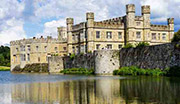 Leeds castle is deceptively situated in Kent, 5 miles (8 km) southeast of Maidstone.
Leeds castle is deceptively situated in Kent, 5 miles (8 km) southeast of Maidstone.
A castle has been on the site since 1119; it was originally built by Robert de Crevecoeur as a Norman stronghold.
In the 13th century it came into the hands of King Edward I, for whom it became a favourite residence and in 1519, Henry VIII transformed the castle for use as a residence for his first wife, Catherine of Aragon. The castle today dates mostly from the 19th century and is built on islands in a lake formed by the River Len
At 900 years old, Leeds Castle sits 30 miles from central London. It was the home of Henry the VIII.
Leeds Castle’s American connections.
Thomas Fairfax, 6th Lord Fairfax of Cameron was born at the castle in 1693 and settled in North America to oversee the Culpeper estates, cementing an ongoing connection between the castle and America. There is a commemorative sundial at the castle telling the time in Belvoir, Virginia and a corresponding sundial in America. Robert Fairfax owned the castle for 46 years until 1793. Robert was the great grandson of Thomas Fairfax who led the parliamentarian attack at the nearby Battle of Maidstone in 1648 and whose doublet worn during the battle is on display.
The last private owner of the castle was the daughter of Almeric Paget, 1st Baron Queenborough and his first wife, Pauline Payne Whitney, an American heiress. Olive Cecilia Paget married Arthur Wilson Filmer. The Wilson Filmers bought Leeds Castle in 1926–27 but were divorced in 1931. Olive retained possession of the castle. In November 1931 she married Sir Adrian William Maxwell Baillie, 6th Baronet, thus gaining the title of Lady Baillie.
Lady Baillie was responsible for refurbishing the interior and adding features such as a 16th-century-style carved-oak staircase.
Tintagel Castle
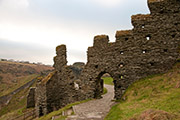 Set high on the rugged North Cornwall coast Tintagel Castle is a ruined medieval fortification located on the peninsula of Tintagel Island, adjacent to the village of Tintagel in Cornwall.
Set high on the rugged North Cornwall coast Tintagel Castle is a ruined medieval fortification located on the peninsula of Tintagel Island, adjacent to the village of Tintagel in Cornwall.
Best known for King Arthur and his Knights of the Round Table Tintagel Castle was built 800 years ago by the Earl of Cornwall, brother of the King of England. The earl was intrigued by the legends of King Arthur and his infamous Camelot. The castle was constructed to resemble the court where it's believed King Arthur reigned for so many years.
The castle saw settlement during the Early Medieval period, when it was probably one of the seasonal residences of the regional king of Dumnonia. In the 13th century, during the Later Medieval period, after Cornwall had been subsumed into the kingdom of England, a castle was built on the site by Richard, Earl of Cornwall, which later fell into disrepair and ruin.
Steeped in myths and mystery, the castle has a long association with Arthurian legends. This began in the 12th century when Geoffrey of Monmouth, in his mythical account of British history which includes a detailed version of the legend. His book; The Historia Regum Britanniae described Tintagel as the place of King Arthur's conception. Geoffrey told the story that Arthur's father, King Uther Pendragon, was disguised by Merlin's sorcery to look like Gorlois; Duke of Cornwall, the husband of Ygerna, Arthur's mother.
Warwick Castle
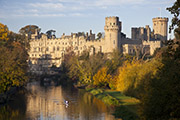 Situated less than 100 miles from London, Warwick Castle is known for its beautiful interior and the medieval re-enactments that take place there. Until 25 years ago, generations of Earls of Warwick had resided in the castle. At the turn of the 20th century, Frances, Countess of Warwick, also known as Daisy, was known around England for her lavish, high-society parties. Some of her guests included Winston Churchill; Edward, Prince of Wales; and the future King Edward VII.
Situated less than 100 miles from London, Warwick Castle is known for its beautiful interior and the medieval re-enactments that take place there. Until 25 years ago, generations of Earls of Warwick had resided in the castle. At the turn of the 20th century, Frances, Countess of Warwick, also known as Daisy, was known around England for her lavish, high-society parties. Some of her guests included Winston Churchill; Edward, Prince of Wales; and the future King Edward VII.
Six hundred years ago, Europe's most famous jousting champion was the Earl of Warwick. In honour, each year thousands of people arrive at Warwick Castle to watch re-enacted jousting competitions.
 Windsor Castle is the oldest and largest inhabited castle in the world. It has been the family home of British kings and queens for almost 1,000 years. It is an official residence of Her Majesty The Queen, whose standard flies from the Round Tower when she is in residence.
Windsor Castle is the oldest and largest inhabited castle in the world. It has been the family home of British kings and queens for almost 1,000 years. It is an official residence of Her Majesty The Queen, whose standard flies from the Round Tower when she is in residence.The Queen spends most of her private weekends at Windsor and takes up official residence for a month over Easter (March to April), known as Easter Court. The Queen is also at Windsor for one week each June, when she attends Royal Ascot and the service of the Order of the Garter. St George’s Chapel within the Castle Precincts is the spiritual home of the Order of the Garter With roots in the Middle Ages the order of the garter is the oldest order of chivalry in the world. Founded at Windsor by Edward III in 1348, the Garter knighthood consists of the monarch, the Prince of Wales (whose title automatically qualifies him as a Knight of the Garter), and 24 knights. Its Knights still attend a Service of Thanksgiving in the chapel of their patron, St George.
Over a million people visit the castle each year. Presidents Jimmy Carter, Ronald Reagan and Bill Clinton have all been guests of the queen at the palace.
The Tower of London
 Officially titled Her Majesty’s Royal Palace And Fortress, The Tower of London; this historic castle is located on the north bank of the River Thames. At the heart of the Tower of London is the White Tower which gives the castle its name. It was built by William the Conqueror in 1078 following the Norman Conquest and at the time the tower would have visually dominated the surrounding area. It was built to strike fear and submission into the citizens of London.
Officially titled Her Majesty’s Royal Palace And Fortress, The Tower of London; this historic castle is located on the north bank of the River Thames. At the heart of the Tower of London is the White Tower which gives the castle its name. It was built by William the Conqueror in 1078 following the Norman Conquest and at the time the tower would have visually dominated the surrounding area. It was built to strike fear and submission into the citizens of London.The castle was used as a prison from 1100 until 1952 and housed the notorious English gangsters the Kray twins who operated out of the East End of London during the 1950’s and 60’s. In its former years the Tower of London was a grand palace serving as a royal residence.
The Tower of London has played a prominent role in English history and controlling it has been important to controlling the country. The Tower has served as an armoury, a treasury, the home of the Royal Mint, a public records office, and the home of the Crown Jewels.
In the late 15th century the castle was the prison of the Princes in the Tower (Edward V of England and Richard of Shrewsbury, Duke of York.) who disappeared among accusations that they were murdered by Richard III who took Edward V’s throne to become King of England. Other royal prisoners included Anne Boleyn; second wife of Henry VIII before she was beheaded, and Elizabeth I their daughter before she became queen. Traitor's Gate, the entrance from the River Thames, is known for being the last stop for those on their way to their execution.
Guarding the Tower
 The Yeoman Warders known as ‘Beefeaters’ guard the Tower of London. They have long been symbols of London with their distinct uniforms. It is thought their nickname is derived from their position in the Royal Bodyguard, which permitted them to eat as much beef as they wanted from the king's table.
The Yeoman Warders known as ‘Beefeaters’ guard the Tower of London. They have long been symbols of London with their distinct uniforms. It is thought their nickname is derived from their position in the Royal Bodyguard, which permitted them to eat as much beef as they wanted from the king's table.They are a detachment of the ‘Yeomen of the Guard’, and they’ve formed the Royal Bodyguard since at least 1509. Their origins stretch back as far as the reign of Edward IV (1461-83).
Legend of the ravens
 Ravens have always been kept at the Tower of London. When Charles II asked for the Ravens to be removed, he was advised that if the Ravens were removed, The Tower would crumble and a great harm would befall the nation. Ever since at least 6 ravens have been kept at the Tower.
Ravens have always been kept at the Tower of London. When Charles II asked for the Ravens to be removed, he was advised that if the Ravens were removed, The Tower would crumble and a great harm would befall the nation. Ever since at least 6 ravens have been kept at the Tower.Despite their having one wing trimmed, some ravens do in fact go absent without leave and others have had to be sacked. Raven George was dismissed for eating television aerials, and Raven Grog was last seen outside an East End pub.
Today the Tower of London is an iconic symbol of London. It is one of the country's most popular tourist attractions with over 2 million visitors every year. Being such a prestigious and important castle it is protected as a World Heritage Site.
Highclere Castle
 Home to the television series Downton Abbey, Highclere is one of England's most beautiful Victorian Castles. The Carnarvon family has lived at Highclere since 1679, and the castle was largely rebuilt for the third Earl following a design by Sir Charles Barry after he had finished with the construction of the Houses of Parliament.
Home to the television series Downton Abbey, Highclere is one of England's most beautiful Victorian Castles. The Carnarvon family has lived at Highclere since 1679, and the castle was largely rebuilt for the third Earl following a design by Sir Charles Barry after he had finished with the construction of the Houses of Parliament.Julian Fellowes Longstanding friend of the Carnarvon family had Highclere Castle in mind as he wrote Downton Abbey. He often commented he wanted a house which spectacularly testified to the confidence and soaring optimism of the Edwardian period and as they say the rest is history.
Leeds Castle
 Leeds castle is deceptively situated in Kent, 5 miles (8 km) southeast of Maidstone.
Leeds castle is deceptively situated in Kent, 5 miles (8 km) southeast of Maidstone.A castle has been on the site since 1119; it was originally built by Robert de Crevecoeur as a Norman stronghold.
In the 13th century it came into the hands of King Edward I, for whom it became a favourite residence and in 1519, Henry VIII transformed the castle for use as a residence for his first wife, Catherine of Aragon. The castle today dates mostly from the 19th century and is built on islands in a lake formed by the River Len
At 900 years old, Leeds Castle sits 30 miles from central London. It was the home of Henry the VIII.
Leeds Castle’s American connections.
Thomas Fairfax, 6th Lord Fairfax of Cameron was born at the castle in 1693 and settled in North America to oversee the Culpeper estates, cementing an ongoing connection between the castle and America. There is a commemorative sundial at the castle telling the time in Belvoir, Virginia and a corresponding sundial in America. Robert Fairfax owned the castle for 46 years until 1793. Robert was the great grandson of Thomas Fairfax who led the parliamentarian attack at the nearby Battle of Maidstone in 1648 and whose doublet worn during the battle is on display.
The last private owner of the castle was the daughter of Almeric Paget, 1st Baron Queenborough and his first wife, Pauline Payne Whitney, an American heiress. Olive Cecilia Paget married Arthur Wilson Filmer. The Wilson Filmers bought Leeds Castle in 1926–27 but were divorced in 1931. Olive retained possession of the castle. In November 1931 she married Sir Adrian William Maxwell Baillie, 6th Baronet, thus gaining the title of Lady Baillie.
Lady Baillie was responsible for refurbishing the interior and adding features such as a 16th-century-style carved-oak staircase.
Tintagel Castle
 Set high on the rugged North Cornwall coast Tintagel Castle is a ruined medieval fortification located on the peninsula of Tintagel Island, adjacent to the village of Tintagel in Cornwall.
Set high on the rugged North Cornwall coast Tintagel Castle is a ruined medieval fortification located on the peninsula of Tintagel Island, adjacent to the village of Tintagel in Cornwall.Best known for King Arthur and his Knights of the Round Table Tintagel Castle was built 800 years ago by the Earl of Cornwall, brother of the King of England. The earl was intrigued by the legends of King Arthur and his infamous Camelot. The castle was constructed to resemble the court where it's believed King Arthur reigned for so many years.
The castle saw settlement during the Early Medieval period, when it was probably one of the seasonal residences of the regional king of Dumnonia. In the 13th century, during the Later Medieval period, after Cornwall had been subsumed into the kingdom of England, a castle was built on the site by Richard, Earl of Cornwall, which later fell into disrepair and ruin.
Steeped in myths and mystery, the castle has a long association with Arthurian legends. This began in the 12th century when Geoffrey of Monmouth, in his mythical account of British history which includes a detailed version of the legend. His book; The Historia Regum Britanniae described Tintagel as the place of King Arthur's conception. Geoffrey told the story that Arthur's father, King Uther Pendragon, was disguised by Merlin's sorcery to look like Gorlois; Duke of Cornwall, the husband of Ygerna, Arthur's mother.
Warwick Castle
 Situated less than 100 miles from London, Warwick Castle is known for its beautiful interior and the medieval re-enactments that take place there. Until 25 years ago, generations of Earls of Warwick had resided in the castle. At the turn of the 20th century, Frances, Countess of Warwick, also known as Daisy, was known around England for her lavish, high-society parties. Some of her guests included Winston Churchill; Edward, Prince of Wales; and the future King Edward VII.
Situated less than 100 miles from London, Warwick Castle is known for its beautiful interior and the medieval re-enactments that take place there. Until 25 years ago, generations of Earls of Warwick had resided in the castle. At the turn of the 20th century, Frances, Countess of Warwick, also known as Daisy, was known around England for her lavish, high-society parties. Some of her guests included Winston Churchill; Edward, Prince of Wales; and the future King Edward VII.Six hundred years ago, Europe's most famous jousting champion was the Earl of Warwick. In honour, each year thousands of people arrive at Warwick Castle to watch re-enacted jousting competitions.
Tea Time
Select Your Currency:
